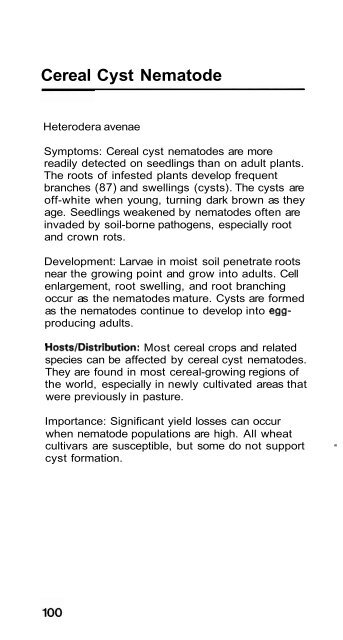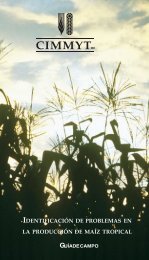Wheat Diseases and Pests - Wheat Doctor - CIMMYT
Wheat Diseases and Pests - Wheat Doctor - CIMMYT
Wheat Diseases and Pests - Wheat Doctor - CIMMYT
You also want an ePaper? Increase the reach of your titles
YUMPU automatically turns print PDFs into web optimized ePapers that Google loves.
Cereal Cyst Nematode<br />
Heterodera avenae<br />
Symptoms: Cereal cyst nematodes are more<br />
readily detected on seedlings than on adult plants.<br />
The roots of infested plants develop frequent<br />
branches (87) <strong>and</strong> swellings (cysts). The cysts are<br />
off-white when young, turning dark brown as they<br />
age. Seedlings weakened by nematodes often are<br />
invaded by soil-borne pathogens, especially root<br />
<strong>and</strong> crown rots.<br />
Development: Larvae in moist soil penetrate roots<br />
near the growing point <strong>and</strong> grow into adults. Cell<br />
enlargement, root swelling, <strong>and</strong> root branching<br />
occur as the nematodes mature. Cysts are formed<br />
as the nematodes continue to develop into egg-<br />
producing adults.<br />
HostslDistribution: Most cereal crops <strong>and</strong> related<br />
species can be affected by cereal cyst nematodes.<br />
They are found in most cereal-growing regions of<br />
the world, especially in newly cultivated areas that<br />
were previously in pasture.<br />
Importance: Significant yield losses can occur<br />
when nematode populations are high. All wheat<br />
cultivars are susceptible, but some do not support<br />
cyst formation.<br />
9



